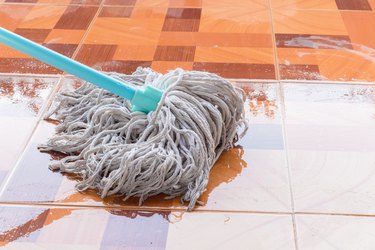
Mopping the floors can be one of the most satisfying chores, largely because of the almost-instant visual reward. However, this enjoyment can be ruined if the floor dries with streaks across it that clearly show where you mopped. To avoid a redo, understand where streaks come from so that you can get the shine you want the first time.
Is Your Mop Leaving Streaks?
Video of the Day
The most likely source of streaks from your mop is the use of the wrong cleaner for the material of your floor. With so many cleaning products on the market, it can be easy to pick one that isn't compatible. Ceramic tile floors need a completely different cleaner than wood or stone floors, and using the wrong one can easily cause streaking, staining or worse.
Video of the Day
A solution of vinegar might work wonders on porcelain, but it can damage travertine (a type of stone tile) floors. You should know what's on the surface of your floor (has it been waxed, sealed or coated, for instance) and what products are compatible with that surface.
Other Causes of Streaks
The second-most-likely culprit is that you're using the cleaning product incorrectly. Even with the right cleaner, if you use too much, the product can build up on the floor and cause unsightly streaks and marks. You may think you need a high concentration to deal with spots, but the best way to manage a stain is to treat it individually beforehand, applying the appropriate cleaning product and a bit of elbow grease to get it to loosen up. Then, mop the floor as usual using a solution at the suggested level of concentration, and go back to stubborn spots later on their own.
If these issues don't appear to be the cause of your streaks, then you might be approaching the problem in the wrong way. For most high-traffic areas like kitchens or bathrooms, start by sweeping or vacuuming any loose dust, dirt or residue, so that all loose matter has been removed before you start mopping. Otherwise, you might spread food oils or bathroom products all over the floor, which will produce streaks of their own. Make sure any loose material is swept up before you even start with the mop.
Streak-Free Mopping
Streak-free floor cleaners and the right mop are the way to start. A microfiber mop is the best mop for hardwood or laminate floors, paired with a cleaner suitable for the surfaces. (Keep in mind that if your wooden floor has been waxed, using additional wax product on it will produce streaking.) For ceramic floors, use a chamois mop with a mild detergent style cleaner. Porcelain and stone floors respond best to a gentle sponge mop with an appropriate cleaning solution.
Vacuum and sweep first to remove loose dust, dirt and other particulates. Then start mopping carefully, starting in the corner farthest from the most high-traffic path through the area; you'll slowly back your way across the floor so that you don't have to step on anything on your way out.
As you mop, make sure you aren't using too much water; damp spots dry unevenly, and, depending on the cleaning product, this can also create minor streaking on your floor. Move evenly across the floor, making sure to frequently rinse the mop. If the mop water becomes dirty, change it, otherwise you're just relocating the dirt you've already removed.